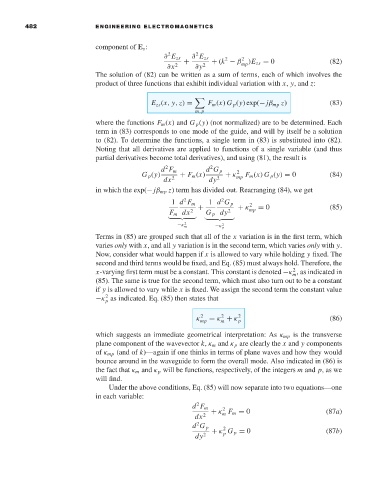Page 500 - Engineering Electromagnetics, 8th Edition
P. 500
482 ENGINEERING ELECTROMAGNETICS
component of E s :
2 2
∂ E zs ∂ E zs + (k − β )E zs = 0 (82)
2
2
∂x 2 + ∂y 2 mp
The solution of (82) can be written as a sum of terms, each of which involves the
product of three functions that exhibit individual variation with x, y, and z:
E zs (x, y, z) = F m (x) G p (y)exp(− jβ mp z) (83)
m,p
where the functions F m (x) and G p (y) (not normalized) are to be determined. Each
term in (83) corresponds to one mode of the guide, and will by itself be a solution
to (82). To determine the functions, a single term in (83) is substituted into (82).
Noting that all derivatives are applied to functions of a single variable (and thus
partial derivatives become total derivatives), and using (81), the result is
2 2
d F m d G p
G p (y) + F m (x) + κ 2 F m (x) G p (y) = 0 (84)
dx 2 dy 2 mp
in which the exp(− jβ mp z) term has divided out. Rearranging (84), we get
2 2
1 d F m 1 d G p 2 = 0 (85)
F m dx 2 + G p dy 2 + κ mp
2 2
−κ m −κ p
Terms in (85) are grouped such that all of the x variation is in the first term, which
varies only with x, and all y variation is in the second term, which varies only with y.
Now, consider what would happen if x is allowed to vary while holding y fixed. The
second and third terms would be fixed, and Eq. (85) must always hold. Therefore, the
2
x-varying first term must be a constant. This constant is denoted −κ ,as indicated in
m
(85). The same is true for the second term, which must also turn out to be a constant
if y is allowed to vary while x is fixed. We assign the second term the constant value
2
−κ as indicated. Eq. (85) then states that
p
2
2
κ mp = κ + κ 2 p (86)
m
which suggests an immediate geometrical interpretation: As κ mp is the transverse
plane component of the wavevector k, κ m and κ p are clearly the x and y components
of κ mp (and of k)—again if one thinks in terms of plane waves and how they would
bounce around in the waveguide to form the overall mode. Also indicated in (86) is
the fact that κ m and κ p will be functions, respectively, of the integers m and p,aswe
will find.
Under the above conditions, Eq. (85) will now separate into two equations—one
in each variable:
2
d F m + κ F m = 0 (87a)
2
dx 2 m
2
d G p + κ G p = 0 (87b)
2
dy 2 p

